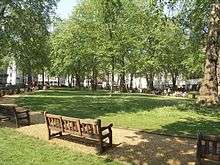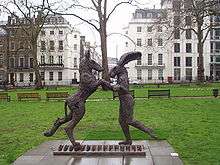Berkeley Square
Berkeley Square /ˈbɑːrkliː/ is a green town square (public garden square) in Mayfair in the West End of London, in the City of Westminster. It was laid out, extending further south, in the mid 18th century by the architect William Kent.




The gardens' very large London Plane trees are among the oldest in central London, planted in 1789. One in the east is a Great Tree of London.
Description
Buildings
Its buildings were predominantly residential, one remains wholly so, No.48.[lower-alpha 1] The square is mostly offices typical of Mayfair including bluechips' meeting spaces, hedge funds, niche headhunters and wealth management businesses.
The buildings' architects included Robert Adam but 9 Fitzmaurice Place (since 1935 home of the Lansdowne Club, earlier known as Shelb(o)urne then Lansdowne House — all three names referring to the same branch of one family) is now on the south corner's approach ("Fitzmaurice Place"). The daring staircase-hall of No.44 is sometimes considered William Kent's masterpiece.[1] Gunter's Tea Shop, founded under a different name in 1757, used to trade here.
50 Berkeley Square is allegedly haunted; it used to be occupied by Maggs Brothers Antiquarian Booksellers.[2]
Approach ways include Berkeley Street, Curzon Street, and Hill Street.
Gardens
The gardens of Berkeley Square are Grade II listed (are in the initial category) on the Register of Historic Parks and Gardens.[3]
The square features a sculptural fountain by Alexander Munro, a Pre-Raphaelite sculptor, made in 1865. On the eastern side is a bronze sculpture of Velasquez' Reina Mariana by Manolo Valdes.
In 2008, one of the trees was said to be the "most valuable street tree in Britain" by the London Tree Officers Association, in terms of its size, health, historical significance and the number of people who live near to it.[4]
History
The square is among those[lower-alpha 2] that demonstrate non-waiver of (no later agreement to forego) restrictive covenants. In 1696, Berkeley House on Piccadilly became Devonshire House when John Berkeley, 3rd Baron Berkeley of Stratton, sold it by deed to William Cavendish, 1st Duke of Devonshire. With express intent to bind later owners Berkeley undertook not to build on land retained very directly behind the house, so keeping the Duke's house's rear view. The southernmost portion saw either a breach and passage of 20 years without claim (the limitation period of deeds) or a release of covenant agreement struck up - it was until about 1930 legally required green space, namely gardens of 9 Fitzmaurice Place.[5] They became the new south side of the square.
Famous residents
Residents have included:
- John Byng (1741), Vice-Admiral, Royal Navy. His home was decorated by architect Isaac Ware
- Horace Walpole 1779 until 1797 death—at No.11
- George Canning, UK Prime Minister (1827)—at No.50
- Winston Churchill—at No.48 as a child
- Robert Clive of India—bought No.45 in 1761, where he committed suicide in 1774
- Sarah Child Villiers, Countess of Jersey (Lady Jersey), one of the famous patronesses of Almack's and leaders of the ton during the Regency era; heiress to the Child & Co. banking fortune—at No.38
- Charles Rolls, co-founder of Rolls-Royce, born here 1877
At Lansdowne House, formerly on the square:
- John Stuart, 3rd Earl of Bute, British Prime Minister (1762–63)
- William Petty, 2nd Earl of Shelburne (later 1st Marquess of Lansdowne), British prime minister (1782–83)
- William Pitt the Younger, British prime minister (1783–1801, 1804–1806)
- William Waldorf Astor, 1st Viscount Astor, richest man in America at the time (1891–1893)
- Archibald Primrose, 5th Earl of Rosebery, Liberal statesman and Prime Minister (1894–1895)
- Harry Gordon Selfridge, founder of the Selfridges department store
Fictional residents
- P.G. Wodehouse's character Bertie Wooster lives near Berkeley Square in a Berkeley St. flat along with his valet Jeeves, not far from the Drones Club.
- Harry Flashman, the vicious bully of Tom Brown's School Days and anti-hero of the Flashman Papers, had a marital home here with his wife Elsperth.
- Cathy Lane, Patty Lane's "identical cousin", is said to have lived here in the theme song to The Patty Duke Show.
- "Tomlinson", the title character of Rudyard Kipling's 1891 satirical poem, "gave up the ghost at his house in Berkeley Square".
- Peter Standish, a character from the play Berkeley Square written by John Balderston, about a Yankee who lives in a house on the square and is transported back to the 18th century. The play was produced as a movie in 1933, with Leslie Howard, and in 1951, and on television in 1959.
- In the 1949 comedy film Kind Hearts and Coronets, Lady Agatha D'Ascogne is made to fall to her death in Berkeley Square to accommodate a clever poetic parody.
- Lady Emily Ashton, created by author Tasha Alexander, lives primarily in her Berkeley Square residence during the Victorian period.
- The Marquis of Alverstoke, the main male character from the novel Frederica by Georgette Heyer.
Transport
Berkeley Square is a typical prime Central London distance from:-
- Green Park Underground station (on the Piccadilly, Jubilee and Victoria lines)
- Bond Street Underground station (on the Central and Jubilee lines).
London Buses route 22 passes through the square.
Berkeley Square hosts vehicle charging points supplied by Elektromotive.
See also
- 50 Berkeley Square, a building described as The Most Haunted House in London.
- Berkeley Square, the 1933 film starring Leslie Howard
- Berkeley Square, a 1998 TV mini-series produced by, and shown on, the BBC.
- The Ghosts of Berkeley Square, 1947 film starring Robert Morley and Felix Aylmer
- 9 Fitzmaurice Place (formerly Lansdowne House when on the Square)
- "A Nightingale Sang in Berkeley Square"—a 1940 song written by Manning Sherwin and Eric Maschwitz, associated in England with singer Vera Lynn or in America with the Glenn Miller Band, and a 1979 film directed by Ralph Thomas.
- The Fleming Collection, a large private collection of Scottish art held in the square.
- List of eponymous roads in London
Notes
- Numbering is from 1 to 57 but many are missed; one building is named with no numbering, Berkeley Square House
- Analogous to locus classicus case concerning Leicester Square, a pillar of this English law, Tulk v Moxhay
References
- Sykes, 104–111
- walksoflondon.co.uk Archived 22 January 2014 at the Wayback Machine—50 Berkeley Square, The Most Haunted House In London, accessed 2008-02-08.
- Historic England, "Berkeley Square (1000516)", National Heritage List for England, retrieved 22 March 2018
- "Plane lovely: The most valuable tree is identified in Berkeley Square". Evening Standard. 21 April 2008.
- 'Berkeley Square, North Side,' in Survey of London: Volume 40, the Grosvenor Estate in Mayfair, Part 2 (The Buildings), ed. F H W Sheppard (London: London County Council, 1980), 64–67, accessed November 21, 2015, online
Sources
- "Berkeley Square, North Side", Survey of London: volume 40: The Grosvenor Estate in Mayfair, Part 2 (The Buildings) (1980) at British History Online (date accessed 5 July 2009)
- "Berkeley Square and its neighbourhood", Old and New London: Volume 4 (1878) at British History Online (date accessed 5 July 2009)
- Sykes, Christopher Simon. Private Palaces: Life in the Great London Houses, Chatto & Windus, 1985
External links
| Wikimedia Commons has media related to Berkeley Square. |